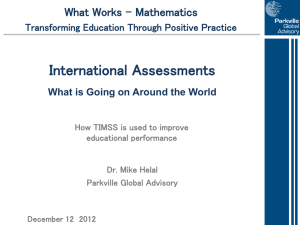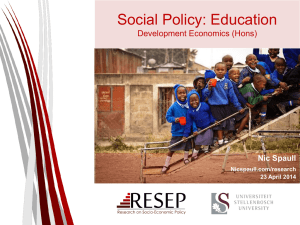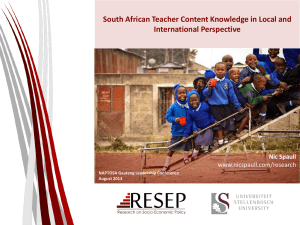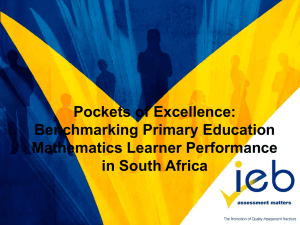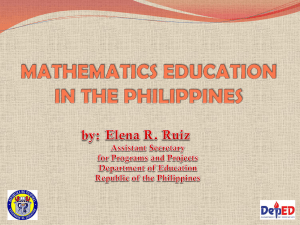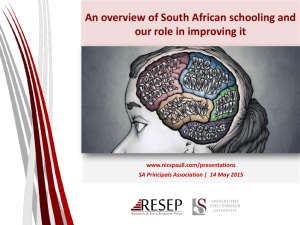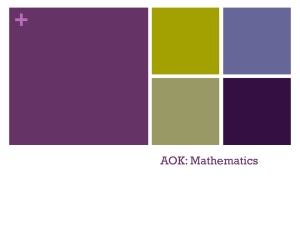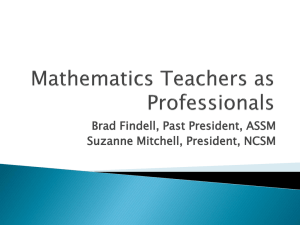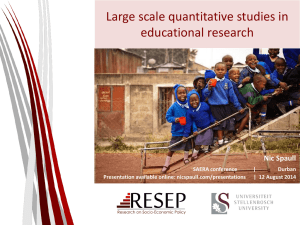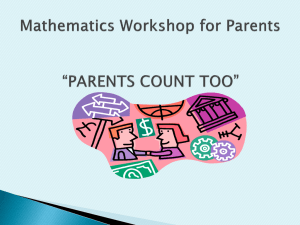timss 2011 - WordPress.com
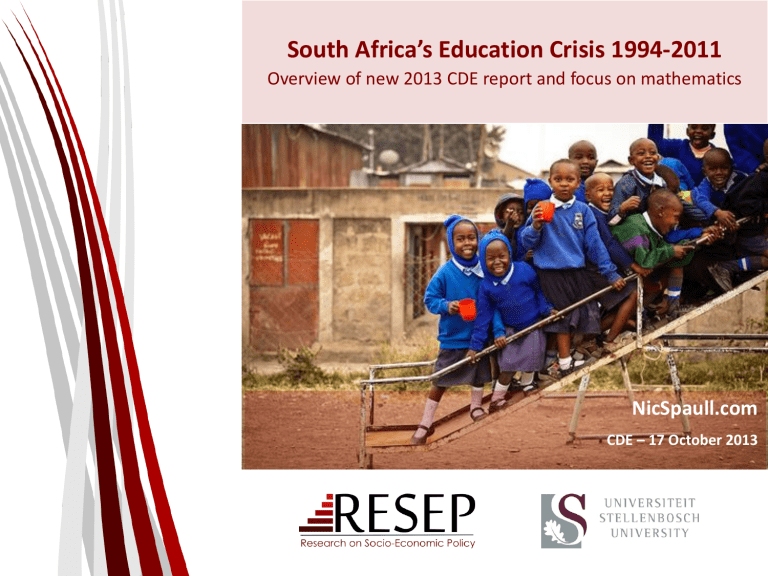
South Africa’s Education Crisis 1994-2011
Overview of new 2013 CDE report and focus on mathematics
NicSpaull.com
CDE – 17 October 2013
Outline
1.
Overview of CDE report
2.
Overview of SA education system
3.
SA students performance in maths
4.
Mathematics item analysis
5.
Teacher content knowledge
6.
Way forward…
2
2013 CDE report: “South Africa’s Education Crisis”
1. Overview of South African children’s performance on local and international assessments of educational achievement
(1995-2011)
2. Grade 6 teacher content knowledge in South Africa
3. National Senior Certificate performance: retention & subject choice
4. Inequality of educational opportunity
5. Insurmountable learning deficits
6. Transitions from school to work and tertiary institutions
7. Policy suggestions & conclusions
3
Bird’s-eye view of the
South African education system
High productivity jobs and incomes (17%)
• Mainly professional, managerial & skilled jobs
• Requires graduates, good quality matric or good vocational skills
• Historically mainly white
• Vocational training
• Affirmative action
Low productivity jobs & incomes
• Often manual or low skill jobs
• Limited or low quality education
• Minimum wage can exceed productivity
Labour Market
University/
FET
• Type of institution
(FET or University)
• Quality of institution
• Type of qualification
(diploma, degree etc.)
• Field of study
(Engineering, Arts etc.)
Some motivated, lucky or talented students make the transition
High quality secondary school High SES background
+ECD
High quality primary school
-
Big demand for good schools despite fees
Some scholarships/bursaries
Minority
(20%)
Unequal society
Majority
(80%)
Low quality secondary schoo l
Low SES background
Low quality primary school
5 cf. Servaas van der Berg – QLFS 2011
SA Gr8/9 maths performance 1995
2011
280
240
200
160
120
80
40
0
480
440
400
360
320
276 275 264
285
352
433
260
243 244
268
332
443
1995 1999 2002 2002 2011 2011 1995 1999 2002 2002 2011 2011
Grade 8 Grade 9 TIMSS middleincome country
Gr8 mean
Grade 8 Grade 9 TIMSS middleincome country
Gr8 mean
TIMSS Mathematics TIMSS Science
• Between 1995 and 2002 there was no improvement in Gr8 mathematics achievement
• Between 2002 and 2011 there was a substantial improvement (approx. 1.5 grade levels) in Gr9 mathematics achievement
• Post-improvement level is still very low; the average SA Grade 9 pupil is two years worth of learning behind the
440
400
360
320
280
240
200
Figure 2: Average Grade Eight mathematics test scores for middle-income countries participating in TIMSS 2011 (+95% confidence intervals around the mean)
600
560
520
480
Middle-income countries South Africa (Gr9)
7
NSES question 42
NSES followed about 15000 students (266 schools) and tested them in Grade 3 (2007), Grade 4 (2008) and
Grade 5 (2009).
100%
90%
80%
70%
60%
50%
40%
30%
20%
10%
0%
59%
13%
13%
16%
Q1
35%
57% 57% 55%
13%
14%
14%
10%
19%
Q2
14%
12%
17%
Q3
Question 42
15%
12%
17%
Q4
(Spaull & Viljoen, forthcoming)
39%
Q5
Still wrong in Gr5
Correct in Gr5
Correct in Gr4
Correct in Gr3
Grade 3 maths curriculum:
“Can perform calculations using appropriate symbols to solve problems involving: division of at least 2-digit by
1-digit numbers”
Even at the end of Grade 5 most (55%+) quintile 1-4 students cannot answer this simple Grade-3-level problem.
“The powerful notions of ratio, rate and proportion are built upon the simpler concepts of whole number, multiplication and division, fraction and rational number, and are themselves the precursors to the development of yet more complex concepts such as triangle similarity, trigonometry, gradient and calculus”
(Taylor & Reddi, 2013: 194)
8
NSES question 37
NSES followed about 15000 students (266 schools) and tested them in Grade 3 (2007), Grade 4 (2008) and
Grade 5 (2009).
100%
90%
80%
70%
60%
50%
40%
30%
20%
10%
0%
38%
17%
22%
23%
Q1
37% 37%
33%
17%
18%
18%
20%
18%
19%
54%
29%
25%
29%
Q2 Q3
Question 37
Q4
(Spaull & Viljoen, forthcoming)
Q5
18%
11%
17%
Grade 3 maths curriculum:
“Can perform calculations using approp symbols to solve problems involving:
MULTIPLICATION of at least
2-digit by 1-digit numbers”
Still wrong in Gr5
Correct in Gr5
Correct in Gr4
Correct in Gr3
Even at the end of Grade 5 more than a third of quintile 1-4 students cannot answer this simple
Grade-3-level problem.
“The powerful notions of ratio, rate and proportion are built upon the simpler concepts of whole number, multiplication and division, fraction and rational number, and are themselves the precursors to the development of yet more complex concepts such as triangle similarity, trigonometry, gradient and calculus”
(Taylor & Reddi, 2013: 194)
9
Systemic 2007 Gr3 NSES 2009 Gr5
Systemic 2007: Grade 3 tested in HL 41% correct
NSES 2009: Grade 5 tested in English 43% correct
SACMEQ 2007 Gr6
SACMEQ 2007: Grade 6 tested in English 21% correct (c)
On a 4-choice MCQ random guessing would produce 25% correct on average
TIMSS 2011 Gr9
TIMSS 2011: Grade 9 tested in
Engl/Afr 27% correct (b)
10
South African teacher content knowledge
Teacher Content Knowledge
• Conference Board of the Mathematical Sciences (2001, ch.2) recommends that mathematics teachers need:
– “A thorough mastery of the mathematics in several grades beyond that which they expect to teach, as well as of the mathematics in
earlier grades” (2001 report ‘The Mathematical Education of
Teachers’)
• Ball et al (2008, p. 409)
– “Teachers who do not themselves know the subject well are not likely to have the knowledge they need to help students learn this content. At the same time just knowing a subject may well not be sufficient for
teaching.”
• Shulman (1986, p. 9)
– “We expect that the subject matter content understanding of the teacher be at least equal to that of his or her lay colleague, the mere subject matter major”
12
South Africa specifically…
• Taylor & Vinjevold’s (1999, p. 230) conclusion in their book “Getting Learning Right” is particularly explicit:
• “
The most definite point of convergence across the
[President’s Education Initiative] studies is the conclusion that teachers’ poor conceptual knowledge of the subjects they are teaching is a fundamental
constraint on the quality of teaching and learning
activities, and consequently on the quality of learning outcomes
.”
13
Carnoy & Chisholm (2008: p. 22) conceptual framework
14
Teacher knowledge
Teachers cannot teach what they do not know.
Demonizing teachers is popular, but unhelpful
“For every increment of performance I demand from you, I have an equal responsibility to provide you with the capacity to meet that
expectation. Likewise, for every investment you make in my skill and knowledge, I have a reciprocal responsibility to demonstrate some new increment in performance”
(Elmore, 2004b, p. 93).
PCK – how to teach fractions
CK – How to do fractions
Student
understands & can calculate fractions
SACMEQ Grade 6 teachers’ average correct response (dark red) and TIMSS Grade 8 average correct response (light red) on 16 items common to Gr 8 TIMSS Mathematics test 1995 and SACMEQ Grade 6 mathematics teachers test 2007
80%
70%
60%
SA Gr6 Teachers
48%
50%
40%
30%
24%
20%
10%
0%
16
17
18
Solutions?
Possible solution…
• The DBE cannot afford to be idealistic in its implementation of teacher training and testing
– Aspirational planning approach: All primary school mathematics teachers should be able to pass the matric mathematics exam
(benchmark = desirable teacher CK)
– Realistic approach: (e.g.) minimum proficiency benchmark where teachers have to achieve at least 90% in the ANA of the grades in which they teach, and
70% in Grade 9 ANA
(benchmark = basic teacher CK)
• Pilot the system with one district. Imperative to evaluate which teacher training option (of hundreds) works best in urban/rural for example.
Rigorous impact evaluations are needed before selecting a program and then rolling it out
• Tests are primarily for diagnostic purposes not punitive purposes
20
Accountability stages...
• SA is a few decades behind many OECD countries. Predictable outcomes as we move from stage to stage. Loveless (2005:
7) explains the historical sequence of accountability movements for students – similar movements for teachers?
– Stage 1 – Setting standards
(defining what students should learn),
– CAPS
– Stage 2 - Measuring achievement
(testing to see what students have
learned),
– ANA
– Stage 3 - Holding educators & students accountable
(making results count).
– Western Cape performance agreements?
Stages in accountability movements:
2) Measuring achievement
“For every increment of performance I demand from you, I have an equal responsibility to provide
you with the capacity to meet that expectation. Likewise, for every investment you make in my skill and knowledge, I have a reciprocal responsibility to demonstrate some new increment in performance” (Elmore, 2004b, p. 93).
1) Setting standards
3) Holding accountable
21
When faced with an exceedingly low and unequal quality of education do we….
A) Increase accountability {US model}
• Create a fool-proof highly specified, sequenced curriculum (CAPS/workbooks)
• Measure learning better and more frequently (ANA)
• Increase choice/information in a variety of ways
B) Improve the quality of teachers {Finnish model}
• Attract better candidates into teaching degrees draw candidates from the top (rather than the bottom) of the matric distribution
• Increase the competence of existing teachers (Capacitation)
• Long term endeavor which requires sustained, committed, strategic, thoughtful leadership (something we don’t have)
C) All of the above {Utopian model}
• Perhaps A while we set out on the costly and difficult journey of B??
22
3
biggest
challenges - SA
1.Failure to get the basics right
• Children who cannot read, write and compute properly (Functionally illiterate/innumerate) after 6 years of formal full-time schooling
• Often teachers lack even the most basic knowledge
2.Equity in education
• 2 education systems – dysfunctional system operates at bottom of African countries, functional system operates at bottom of developed countries.
• More resources is NOT the silver bullet – we are not using existing resources
3.Lack of accountability
• Little accountability to parents in majority of school system
• Little accountability between teachers and Department
• Teacher unions abusing power and acting unprofessionally
23
Decreasing proportion of matrics taking mathematics
Grade 10 (2 years earlier)
Those who pass matric
Proportion of matrics taking mathematics
Grade 12
Pass matric with maths
1200000
1000000
800000
600000
400000
200000
0
Matric 2008 (Gr 10 2006) Matric 2009 (Gr 10 2007) Matric 2010 (Gr 10 2008) Matric 2011 (Gr 10 2009)
0%
2008
2009
2010
2011
Numbers wrote maths
298 821
290 407
263 034
224 635
Numbers passed maths
136 503
133 505
124 749
104 033
Maths pass rate
45,7%
46,0%
47,4%
46,3%
Table 4: Mathematics outputs since 2008 (Source: Taylor, 2012, p. 4)
Proportion taking maths
56,1%
52,6%
48,8%
45,3%
Proportion passing maths
25,6%
24,2%
23,2%
21,0%
24
60%
50%
40%
30%
20%
10%
Way forward?
1.
Acknowledge the extent of the problem
• Low quality education is one of the three largest crises facing our country (along with
HIV/AIDS and unemployment). Need the political will and public support for widespread reform.
2.
Focus on the basics
• Every child MUST master the basics of foundational numeracy and literacy these are the
•
•
•
• building blocks of further education – weak foundations = recipe for disaster
Teachers need to be in school teaching (re-introduce inspectorate?)
Every teacher needs a minimum competency (basic) in the subjects they teach
Every child (teacher) needs access to adequate learning (teaching) materials
Use every school day and every school period – maximise instructional time
3. Increase information, accountability & transparency
•
•
•
At ALL levels – DBE, district, school, classroom, learner
Strengthen ANA
Set realistic goals for improvement and hold people accountable
25
